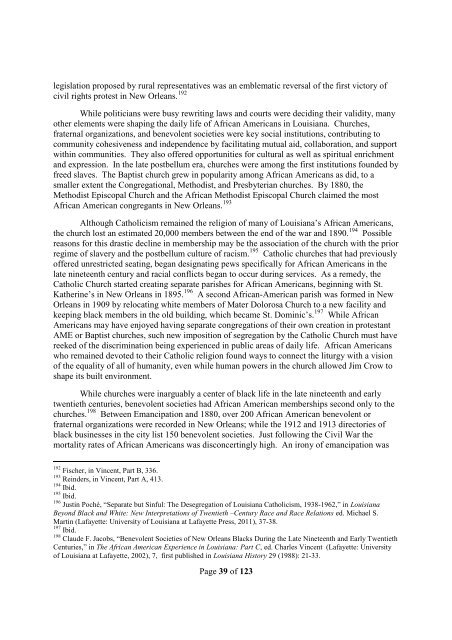The African American Experience in Louisiana
The_African_American_Experience_in_Louisiana
The_African_American_Experience_in_Louisiana
- No tags were found...
You also want an ePaper? Increase the reach of your titles
YUMPU automatically turns print PDFs into web optimized ePapers that Google loves.
legislation proposed by rural representatives was an emblematic reversal of the first victory of<br />
civil rights protest <strong>in</strong> New Orleans. 192<br />
While politicians were busy rewrit<strong>in</strong>g laws and courts were decid<strong>in</strong>g their validity, many<br />
other elements were shap<strong>in</strong>g the daily life of <strong>African</strong> <strong>American</strong>s <strong>in</strong> <strong>Louisiana</strong>. Churches,<br />
fraternal organizations, and benevolent societies were key social <strong>in</strong>stitutions, contribut<strong>in</strong>g to<br />
community cohesiveness and <strong>in</strong>dependence by facilitat<strong>in</strong>g mutual aid, collaboration, and support<br />
with<strong>in</strong> communities. <strong>The</strong>y also offered opportunities for cultural as well as spiritual enrichment<br />
and expression. In the late postbellum era, churches were among the first <strong>in</strong>stitutions founded by<br />
freed slaves. <strong>The</strong> Baptist church grew <strong>in</strong> popularity among <strong>African</strong> <strong>American</strong>s as did, to a<br />
smaller extent the Congregational, Methodist, and Presbyterian churches. By 1880, the<br />
Methodist Episcopal Church and the <strong>African</strong> Methodist Episcopal Church claimed the most<br />
<strong>African</strong> <strong>American</strong> congregants <strong>in</strong> New Orleans. 193<br />
Although Catholicism rema<strong>in</strong>ed the religion of many of <strong>Louisiana</strong>’s <strong>African</strong> <strong>American</strong>s,<br />
the church lost an estimated 20,000 members between the end of the war and 1890. 194 Possible<br />
reasons for this drastic decl<strong>in</strong>e <strong>in</strong> membership may be the association of the church with the prior<br />
regime of slavery and the postbellum culture of racism. 195 Catholic churches that had previously<br />
offered unrestricted seat<strong>in</strong>g, began designat<strong>in</strong>g pews specifically for <strong>African</strong> <strong>American</strong>s <strong>in</strong> the<br />
late n<strong>in</strong>eteenth century and racial conflicts began to occur dur<strong>in</strong>g services. As a remedy, the<br />
Catholic Church started creat<strong>in</strong>g separate parishes for <strong>African</strong> <strong>American</strong>s, beg<strong>in</strong>n<strong>in</strong>g with St.<br />
Kather<strong>in</strong>e’s <strong>in</strong> New Orleans <strong>in</strong> 1895. 196 A second <strong>African</strong>-<strong>American</strong> parish was formed <strong>in</strong> New<br />
Orleans <strong>in</strong> 1909 by relocat<strong>in</strong>g white members of Mater Dolorosa Church to a new facility and<br />
keep<strong>in</strong>g black members <strong>in</strong> the old build<strong>in</strong>g, which became St. Dom<strong>in</strong>ic’s. 197 While <strong>African</strong><br />
<strong>American</strong>s may have enjoyed hav<strong>in</strong>g separate congregations of their own creation <strong>in</strong> protestant<br />
AME or Baptist churches, such new imposition of segregation by the Catholic Church must have<br />
reeked of the discrim<strong>in</strong>ation be<strong>in</strong>g experienced <strong>in</strong> public areas of daily life. <strong>African</strong> <strong>American</strong>s<br />
who rema<strong>in</strong>ed devoted to their Catholic religion found ways to connect the liturgy with a vision<br />
of the equality of all of humanity, even while human powers <strong>in</strong> the church allowed Jim Crow to<br />
shape its built environment.<br />
While churches were <strong>in</strong>arguably a center of black life <strong>in</strong> the late n<strong>in</strong>eteenth and early<br />
twentieth centuries, benevolent societies had <strong>African</strong> <strong>American</strong> memberships second only to the<br />
churches. 198 Between Emancipation and 1880, over 200 <strong>African</strong> <strong>American</strong> benevolent or<br />
fraternal organizations were recorded <strong>in</strong> New Orleans; while the 1912 and 1913 directories of<br />
black bus<strong>in</strong>esses <strong>in</strong> the city list 150 benevolent societies. Just follow<strong>in</strong>g the Civil War the<br />
mortality rates of <strong>African</strong> <strong>American</strong>s was disconcert<strong>in</strong>gly high. An irony of emancipation was<br />
192 Fischer, <strong>in</strong> V<strong>in</strong>cent, Part B, 336.<br />
193 Re<strong>in</strong>ders, <strong>in</strong> V<strong>in</strong>cent, Part A, 413.<br />
194 Ibid.<br />
195 Ibid.<br />
196 Just<strong>in</strong> Poché, “Separate but S<strong>in</strong>ful: <strong>The</strong> Desegregation of <strong>Louisiana</strong> Catholicism, 1938-1962,” <strong>in</strong> <strong>Louisiana</strong><br />
Beyond Black and White: New Interpretations of Twentieth –Century Race and Race Relations ed. Michael S.<br />
Mart<strong>in</strong> (Lafayette: University of <strong>Louisiana</strong> at Lafayette Press, 2011), 37-38.<br />
197 Ibid.<br />
198 Claude F. Jacobs, “Benevolent Societies of New Orleans Blacks Dur<strong>in</strong>g the Late N<strong>in</strong>eteenth and Early Twentieth<br />
Centuries,” <strong>in</strong> <strong>The</strong> <strong>African</strong> <strong>American</strong> <strong>Experience</strong> <strong>in</strong> <strong>Louisiana</strong>: Part C, ed. Charles V<strong>in</strong>cent (Lafayette: University<br />
of <strong>Louisiana</strong> at Lafayette, 2002), 7, first published <strong>in</strong> <strong>Louisiana</strong> History 29 (1988): 21-33.<br />
Page 39 of 123


